PLA History
Major events in PLA's history 1997-2007
(mod.gov.cn)
Updated: 2009-08-27 11:43
 |
Large Medium Small |
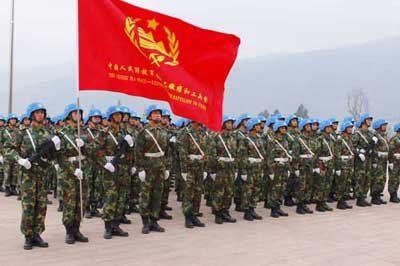 |
|
In May 1997, the Chinese government decided, in principle, to take part in the UN's stand-by arrangements for its peacekeeping operations. [Photo/PLA Daily] |
From Feb. 20 to May 28, 1997, a ship formation of the PLA Navy visited the United States, Mexico, Peru and Chile. During this out-going visit, with a voyage of more than 24,000 sea miles, the naval ship formation made two firsts in PLA Navy's history, i.e. to cross the Pacific Ocean for the first time and arrived in the US mainland and the South American continent for the first time. This four-nation visit also set several records in PLA Navy's history of foreign exchange in the size, duration, voyage, number of countries and cities visited.
On June 19, 1997, the "Galaxy-3" supercomputer developed by the Computer Research Institute of the National University of Defense Technology with a capability of 10,000 million theoretical operations per second (MTOPS) passed the national technological appraisal.
On July 31, 1997, a grand rally marking the 70th anniversary of the founding of the Chinese People's Liberation Army (PLA) was held in Beijing.
|
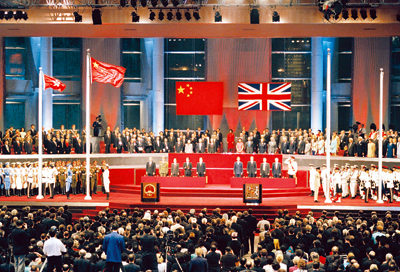 From midnight of June 30 to wee hours of July 1, 1997, the handover ceremony of the political power of Hong Kong between the governments of the People's Republic of China (PRC) and the UK was held solemnly at the Hong Kong Convention and Exhibition Center in Hong Kong. [PLA Daily]
|
The year of 1998
In early February 1998, the Military Training Information Network of the PLA covering all the major units of the PLA and some military academies was basically formed.
On April 3, 1998, the General Armaments Department (GAD) of the PLA was set up. The establishment of the GAD, the leading body of the armaments management and development of the PLA, put an end to the three general headquarters/departments system (the General Staff Headquarters, the General Political Department, the General Logistics Department) lasting 40 years.
President Jiang Zemin signed on Dec. 30 the No. 13 Order of the President of the People's Republic of China to publish the Decision on Revising the Military Service Law of the People's Republic of China adopted at the 6th Session of the Standing Committee of the Ninth National People's Congress on December 29, 1998. According to the Decision, the term of service for conscripts was shortened from 3 years to 2 years and the practice of extension of service was also abolished.
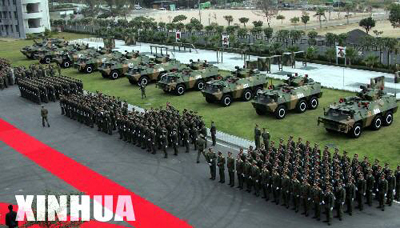 |
|
At 13:00 of December 20, 1999, the troops of the PLA Macao Garrison entered and started to be stationed in Macao. [Photo/PLA Daily] |
The year of 1999
In early February 1999, the General Staff Headquarters, the General Political Department, the General Logistics Department and the General Armaments Department of the PLA jointly awarded the medals of first-class unit in military training to 12 units at division and brigade level of the PLA Air Force. It was the first time in the history of the PLA to conduct the assessment of top class units in military training at division and brigade level, marking the gradual perfection of the military training examination and assessment system of the PLA.
According to an order signed by Chairman of the Central Military Commission Jiang Zemin on April 26, 1999, the National University of Defense Technology (NUDT) incorporated with another three military academies located in Changsha to form a new National University of Defense Technology. A grand rally marking the establishment of the new NUDT was held in Changsha on June 18. The enlarged NUDT was entrusted with the missions of producing high-level professionals in scientific research and engineering technology and high-level commanding officers for the PLA, training high-ranking leading officers of the PLA, and working at research of advanced weapons and equipment and key national defense technologies.
In early September 1999, troops from the Army, the Navy, the Air Force and the Second Artillery Force in the Nanjing and Guangzhou War Theatres, militia and reserve forces in the two war theatres launched a large-scale joint sea-crossing and landing exercise involving actual troops of multi-services and arms in the east Zhejiang and south Guangdong coastal areas.
On the morning of October 1, a grand rally celebrating the 50th anniversary of the founding of the People's Republic of China was held in the Tian'anmen Square in Beijing. Jiang Zemin, Chinese president and chairman of the Central Military Commission, reviewed the square formations formed by servicemen from the Army, the Navy, the Air Force, the reserve force of the PLA, the Armed Police Force and militiamen.
The year of 2000
The State Council and the Central Military Commission (CMC) jointly issued the Decision on establishing the System for Training Military Cadres by reliance on Regular Institutions of Higher Learning on May 30, 2000. The Decision defines such major modes of training and cultivating officers as selecting trainees from on-campus students of regular universities, enrolling national defense-oriented students, and directly recruiting graduates of the year from regular universities. It indicated that the PLA made another major reform on the system of military officer cultivation since the CMC decided to carry out the system of promoting officers through education in military universities and colleges in early 1980s.
On October 16, 2000, the State Council Information Office issued the white paper entitled China's National Defense in 2000.
The year of 2001
At 1:00 am of January 10, 2001, the first unmanned spaceship named Shenzhou II, developed independently by China, was successfully launched in the Jiuquan Satellite Launch Center. After orbiting for seven days, it landed precisely in the middle part of Inner Mongolia at 19:22 of January 16, laying a firm foundation for manned space flight in the years to come.
On January 12, 2001, Zhu Rongji, premier of the State Council, and Jiang Zemin, chairman of the Central Military Commission, signed the No. 298 Order of the State Council and the Central Military Commission to promulgate the Implementation Measures for the "Law of the PRC on Protecting Military Facilities". The Measures came into effect as of the date of its promulgation.
On April 28, 2001, the National Defense Education Law of the PRC was approved at the 21st Session of the Standing Committee of the Ninth National People's Congress. It is the first important law of China to reform and normalize the national defense education in an all-around way.
The PLA held an exercise of actual troops under the background of a joint landing operation on the Dongshan Island in June of 2001. During the exercise, the troops drilled the coordinating method of various services and arms in joint landing operation. It is the largest three-service exercise of joint landing operation since the founding of the PLA as evidenced by the most advanced weapons and equipment, the longest distance of maneuver, the largest number of high-ranking officers, the most complete services and arms, and the largest number of participating servicemen.
The year of 2002
The Regulations on the Appointment and Removal of the PLA Officers in Active Service was promulgated and put into effect on January 4, 2002.
China officially participated in first-grade standby arrangement system for UN peacekeeping operations in January 2002. It indicated that China took the first step towards the actual participation in the UN peacekeeping operations after it decided in principle to joint the standby arrangement system for UN peacekeeping operations in May 1997.
On March 28, 2002, China officially notified the International Atomic Energy Agency that China had completed all domestic legal procedures for the entry into force of the additional protocol of the Treaty on the Non-Proliferation of Nuclear Weapons (NPT). The additional protocol came into effect in China on the same day.
China and Kyrgyzstan held a joint anti-terrorism military exercise on October 11, 2002. The two-day exercise was carried out in two stages. It is the first time for China to hold an anti-terrorism exercise together with a foreign country since the founding of the People's Republic of China. And it is also the first time for the PLA in its history to participate in an exercise out of the territory.
On August 22, 2002, the Chinese government promulgated the Regulations of the PRC on Export Control of Missiles & Related Items and Technologies and the Export Control List. It indicated that the Chinese government took another important measure in conformity with the non-proliferation policy.
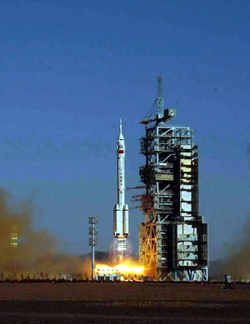 |
|
On October 16, 2003, China's first manned space flight got success. [Photo/PLA Daily] |
The year of 2003
On February 17, nine types of China-made advanced medical service equipment including field ambulances, epidemic prevention vehicles and medical kit sets were loaded on board a ship in the Tianjin New Port. They left China for Congo (K) together with a Chinese medical detachment that participated in UN peacekeeping operation. It is the fist time for the Chinese medical service equipment to serve abroad.
Upon the approval of the CPC Central Committee and the Central Military Commission, the revised Regulations of the PLA on Political Work was promulgated on December 5, 2003. The revised Regulations regardes the political work as the basic guarantee for the Party to exercise the absolute leadership over the armed forces and for the armed forces to perform their functions. It clearly puts forward that the political work is an important factor to form combat effectiveness and stresses to give full play to the operational function of the political work.
The year of 2004
The CPC Central Committee, the State Council and the Central Military Commission issued the Opinions on Further Strengthening the Building of Reserve Force on March 1, 2004. The Opinions points out that efforts should be made to build a reliable and effective reserve force with proper size, reasonable structure and scientific composition.
The PLA Postdoctoral Information Center was set up in the Nanjing General Hospital under the Nanjing Military Area Command in May 2004. The center takes charge of building and operating a network for military postdoctoral administration, information release and policy consultation.
The General Staff Headquarters of the PLA promulgated the Serviceperson's Physical Fitness Standards of the PLA for trial implementation in June 2004. The standards are composed of three parts: the standard for leading bodies, the standard for troops and the standard for educational institutions.
The year of 2005
The Chinese PLA and the Russian Armed Forces staged a joint military exercise codenamed "Peace Mission 2005" from August 18 to 25, 2005. The exercise aimed at enhancing operational capabilities of both militaries to effectively respond to new challenges and threats. Nearly 10,000 troops from the two sides participated in the exercise held in land , sea and air territories of the two countries.
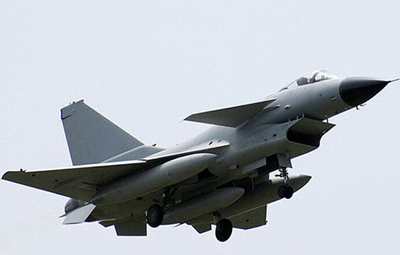 |
|
In December 2006, the J-10 Fighter Aircraft developed independently by China was officially fielded in the aviation units of the PLA Air Force to form actual combat power. [Photo/PLA Daily] |
The year of 2006
The national key laboratory for injury, burn and combined injury, the first national key laboratory in the PLA, passed the acceptance test by an expert group assigned by the Ministry of Science and Technology in the Third Military Medical University on January 1, 2006. This is the first national key laboratory and the only one of its kind officially approved and built. The establishment of the laboratory indicated that the scientific research force of the PLA was formally included into the national innovation system.
Upon the approval of the Central Military Commission, the General Staff Headquarters, the General Political Department, the General Logistics Department and the General Armaments Department of the PLA jointly promulgated the Regulations of the PLA on Rewarding Professional and Technical Personnel in March 2006. According to the Regulations, the prize money for individual could be as high as 100,000 yuan.
The PLA Comprehensive Military Information Network was formally put into operation on August 25, 2006.
The year of 2007
From May 15 to May 20, 2007, the PLA Navy assigned its ship to participate in the multilateral maritime military exercise under the framework of the Western Pacific Navy Symposium (WPNS) for the first time .
On August 1, the Chinese People's Liberation Army (PLA) started a change of military uniforms for the Army , the Navy and the Air Force. It was the military uniform change of the largest size in the history of the PLA.
From August. 9 to 17, 2007, troops of the Shanghai Cooperation Organization member states held a joint anti-terrorism military exercise code named "Peace Mission 2007" in Chelyabinsk of Russia.
On November 28, 2007, the "Shenzhen" missile destroyer of the PLA Navy arrived at Tokyo for a 4-days' friendly visit to Japan. The "Shenzhen" missile destroyer was the first Chinese naval ship to visit Japan, indicating that China and Japan opened a new chapter in the annals of defense exchange.
From December 19 to 27, 2007, the Chinese and Indian army troops carried out a joint anti-terrorism military exercise in Kunming, the capital of southwest China's Yunnan Province.